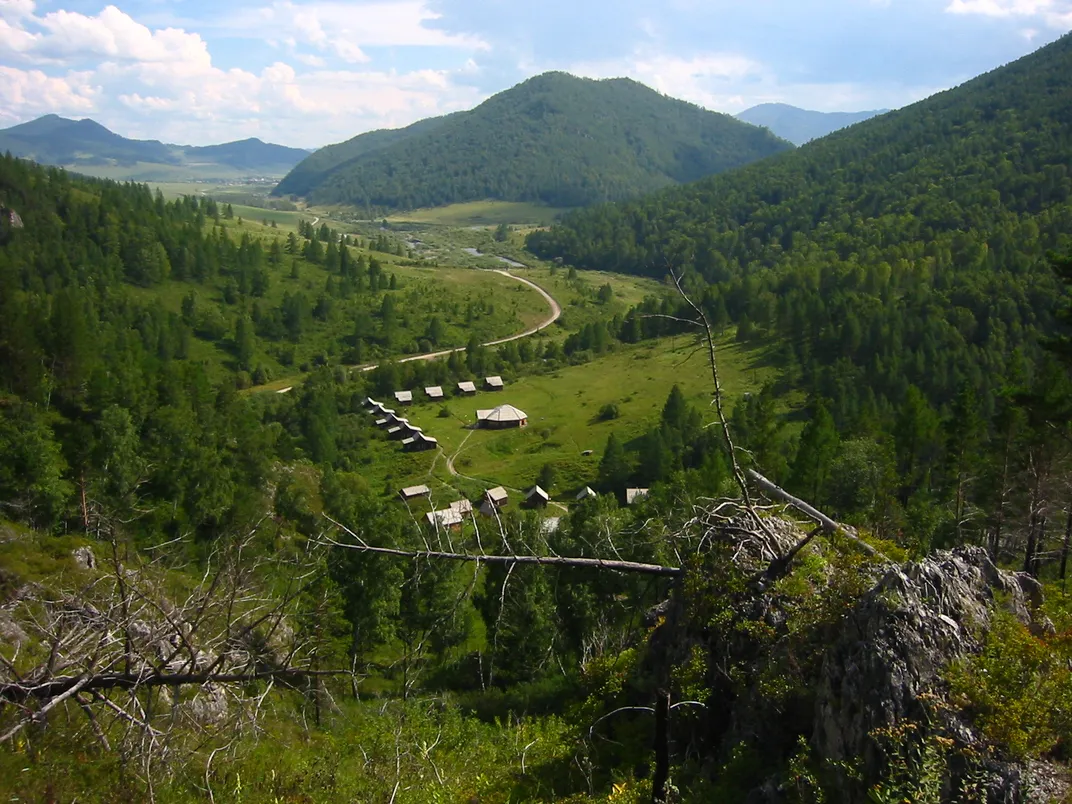Meet Denisova 11: First Known Hybrid Hominin
The 13-year-old girl’s mother was a Neanderthal while her father was a Denisovan
/https://tf-cmsv2-smithsonianmag-media.s3.amazonaws.com/filer/1b/c4/1bc49446-a2a7-478a-acdc-f6dadd065675/01_bonefragment_denisova11uniofoxford.jpg)
Romeo and Juliet may be history’s most enduring pair of star-crossed lovers, but they certainly weren’t the first to fall for a purportedly off-limits partner. Some 90,000 years before William Shakespeare first brought the warring Capulets and Montagues to life, two hominins overcame what seems like an insurmountable obstacle—one was a Neanderthal, the other an entirely different species known as the Denisovan—to create a thriving interspecies family.
The offspring of this unconventional coupling, a young girl scientists have dubbed Denisova 11, lived in modern-day Siberia, Maya Wei-Haas reports for National Geographic. She died young, likely around age 13, and was laid to rest in a cave perched along the remote Altai Mountain range.
Tens of thousands of years after Denisova’s untimely death, one of her bone fragments has provided the first conclusive evidence of early human interbreeding. The landmark discovery, documented in this week’s issue of Nature, suggests that Neanderthals, Denisovans and modern humans not only peacefully co-existed, but willingly mated. If so, the story of Denisova’s Neanderthal mother and Denisovan father may be less about star-crossed lovers than an unusual, albeit fairly common, hybrid coupling.
According to The New York Times’ Carl Zimmer, scientists first identified the Denisovan species in 2010, when they found a bone fragment representing a previously unknown group of early humans. Although the Denisovans are distinct from Neanderthals and modern humans, researchers know little about their appearance or behavior. The five known members of the species, including Denisova 11, were all discovered in the Altai Mountain cave, which has yielded roughly 2,000 damaged bone fragments dating as far back as 120,000 years ago.
The Denisovans’ physical legacy is scarce: To date, researchers have only attributed three teeth, a pinky and either an arm or leg fragment to the mysterious species.
Still, this scant evidence is enough to show that Denisovans and Neanderthals split from a common ancestor roughly 390,000 years ago, Wei-Haas writes, and to point toward both species’ eventual decline around 40,000 years ago.

BBC News’ Helen Briggs notes that Neanderthals lived largely in the western regions of Eurasia, while Denisovans strayed closer to the east. As the former migrated east, however, chance encounters between the two groups likely resulted in interspecies mingling.
“Neanderthals and Denisovans may not have had many opportunities to meet," Svante Pääbo, director of the Max Planck Institute for Evolutionary Anthropology in Leipzig, Germany, tells Briggs. "But when they did, they must have mated frequently—much more so than we previously thought."
Viviane Slon, a researcher at the Max Planck Institute, led DNA analysis of the Denisova 11 bone. Using a technique known as collagen peptide mass fingerprinting, she and her colleagues identified the fragment as part of a human arm or leg bone belonging, based on the bone’s thickness, to an individual at least 13 years old.
Slon extracted mitochondrial DNA, which contains distinct genes passed on by one’s mother, from the sample and found that it contained genetic material similar to that seen in Neanderthals. Further analysis of the fragment’s nuclear DNA (inherited from both parents), however, yielded equal amounts of Denisovan DNA.
“My first reaction was, ‘What did I do wrong?’” Slon tells The Atlantic’s Sarah Zhang. Doubting the abnormal findings, she repeated the DNA extractions a total of six times. Each test ended with the same result.
“It’s really when we saw this over and over again we realized, in fact, it was mixed Neanderthal and Denisovan ancestry,” Slon explains.
According to The New York Times’ Zimmer, Denisova 11’s mother was more closely related to Neanderthals dwelling in western Europe than those residing in the Siberian cave some 120,000 years ago. Denisova’s paternal relatives, on the other hand, stuck to the region surrounding the cave—Denisova 3, the hominin whose pinky toe first led scientists to the species, lived in the area a few thousand years after Denisova 11.
Denisova 11 wasn’t the only hybrid human in her family: Inverse’s Sarah Sloat reports that the girl’s father had at least one Neanderthal ancestor, providing evidence of yet another interspecies coupling.
Today, both Neanderthal and Denisovan genes continue to crop up in modern humans’ DNA. Two percent of most European and Asian populations’ DNA is Neanderthal, National Geographic’s Wei-Haas writes, while four to six percent of modern Melanesians’ DNA derives from Denisovans.
The enduring genetic footprint of these early human species, as well as the interbreeding insights provided by Denisova 11’s tiny bone fragment, suggests that interspecies hybrids may not have been an anomaly as scientists have long believed.
“When you find a needle in a haystack, you have to start wondering if what you’re really looking at is a needlestack,” John Hawks, an anthropologist at the University of Wisconsin-Madison who was not involved in the study, tells The Atlantic’s Zhang. “This genome shows that hybrids were nowhere near as rare as people have been assuming. They must have been really common.”
/https://tf-cmsv2-smithsonianmag-media.s3.amazonaws.com/accounts/headshot/mellon.png)
/https://tf-cmsv2-smithsonianmag-media.s3.amazonaws.com/accounts/headshot/mellon.png)